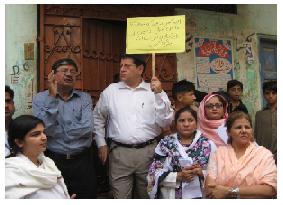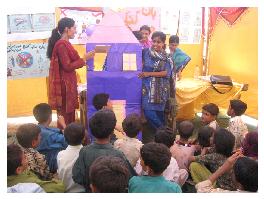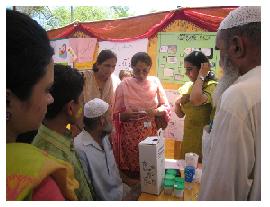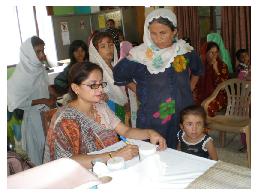Interview with Dr. Muhammad Yousuf
Dr. Muhammad Yousuf is the Principal Coordinator of the Urban Health Program in the Department of Community Health Sciences at Aga Khan University. In this interview, he discusses what makes the Urban Health Program unique, the role of students in the project, and the best practices they have identified for public health programs in Pakistan and around the world.
TN: What was the initial motivation for starting the Urban Health Program? What community needs does it address?
The Community Health Sciences department was established in 1983. Its mandate was to help in  developing community based knowledge and skills and leadership qualities among the students. In 1985, the department began an ambitious Urban Health Program to achieve its mandate.
developing community based knowledge and skills and leadership qualities among the students. In 1985, the department began an ambitious Urban Health Program to achieve its mandate.
We conducted a house-to-house survey with students and staff. We also met community activists and shared the information with them. The community decided what areas to work on and prioritized the needs. We supported community activists to form a community-based organization to work with them. They helped with training and building capacity, creating by-laws, process accounts, and keeping records. The program addresses basic health and development needs of the communities.
TN: What is an example of the Urban Health Program’s work?
The key in Karachi is that there are so many people living in poverty. One peri urban village called Rehri Goth is 300 years old. People there are all working in the fishing industry and the village is very close to an industrial and manufacturing area. The runoff goes right into the sea water by this village. The population there is increasing, but they are not able to generate income from any other area besides fishing. The poverty there was getting worse and worse.
The Urban Health Program and local community based organizations tried to talk to the environmental protection agency and the industry to try to protect them from this hazard. We also encouraged the government to provide vocational training. Now they will have access to additional training. We have worked in another field site, Sultanabad, with sanitation and water officials. Even though the population has doubled in the last 10 years, the public service department had little impact on the overall improvement. In 2000, the Prince of Jordan visited Sultanabad although there were 2 feet of unsanitary water in front of the school. He was moved and donated a handsome amount for community betterment. Afterwards, we worked to link the school sanitation system with the main system. This was incredibly difficult, but we worked very hard to make this happen, to convince local officials and raise money. You would never believe that this is in the heart of the city. We also worked to set up a government health clinic. Though the site was quite expensive and the “land grabbers” were encroaching on it, the Urban Health Program was successful in getting the site.
TN: What benefits do students gain from their involvement with the program?
 At the time of establishment of Aga Khan University medical college in 1983, it was felt that medical training had so far been restricted to clinical hospitals only; and the link with communities where the actual problems are, were missing. The University started the CHS Department with a community-based program where students, faculty and staff can be trained in community health sciences disciplines so as to be leaders in addressing issues in developing countries.
At the time of establishment of Aga Khan University medical college in 1983, it was felt that medical training had so far been restricted to clinical hospitals only; and the link with communities where the actual problems are, were missing. The University started the CHS Department with a community-based program where students, faculty and staff can be trained in community health sciences disciplines so as to be leaders in addressing issues in developing countries.
That is why we are training students and sending them to sites to learn the real conditions. They learn about the major health problems and challenges that communities face. Students do counseling, health education, assess nutrition, health screening, child and maternal healthcare. They may also do some research and help explore problems of the community. The nursing students identified gaps the immunization program in one sector and they worked to correct it.
One elective student from an American University worked at a field site, studying the health education and health messages. She designed a program so that the community members draw pictures to show they understand the health and sanitation training, as they are not literate. She shared this idea with others in her university to initiate a pilot program. It helps increase the public understanding of health education given by the medical and nursing students.
The community health sciences was not getting proper attention when our department started it, but now more and more medical schools see public health and community health sciences as more and more essential.
TN: What advice would you give to institutions that wish to implement a public health program similar to the one at Aga Khan University?
We would like to give the following suggestions:
Identifying needs and planning the project
• Develop strategies to work at grass root level
• Focus should be on the issues concerning communities
Community involvement
• Involve the communities and promote their participation
• Motivate the communities for volunteerism
• Special focus should be on women mobilization
• Strategies for inter-sectoral approach should be developed to resolve issues which are important for communities
• Implementation team should be committed to community oriented approach and be competent enough to understand community dynamics
Forming partnerships
• Develop meaningful partnerships with different stakeholders in the communities
• Foster linkages with government and other non-governmental organizations
Funding and sustainability
• Funding resources should be explored with preference to indigenous resources
• Right from the beginning, sustainability of the program should be considered and in this regard user charges may be introduced
Dissemination
• Document and report your experiences and results of working with the communities in national and international journals for wider dissemination
TN: What best practices have you identified for managing a civic engagement program?
We have identified the following best practices:
Identifying needs and planning the project
• Interaction with community representatives and activists since beginning of the project.
• Conducting baseline need assessment survey by involving the community.
Organization and sustainability
• Formation of community based organization (CBO) around the basic issues and problems arising out of the baseline survey.
• Facilitation of the CBO members to formulate byelaws and get their organization registered with Social Welfare Department.
• Capacity building programs for CBO such as Primary Health Care (PHC), CBO Management, Project proposal writing.
• Facilitation of the CBO to identify male and female volunteers to support the PHC program and also arrange programs for their capacity building.
• Partnership development between communities and AKU-CHS for each of the main initiative and activity.
• Development of teaching, service and research based activities involving different cadres of students.
• Promotion of self -reliance and sustainability through capacity building of all the stakeholders, identification of indigenous resources and keeping nominal user charges for PHC services.
TN: What does winning the MacJannet Prize for Global Citizenship mean for the Urban Health Program?
It’s an honor, appreciation and recognition of work; an encouragement and morale boosting for Urban Health Program, its team, our students, the communities and all other the stakeholders involved. We shall work even harder to achieve more in partnership with communities.
TN: What are your future plans for the program?
 • Replication of the program in other squatter settlements of Karachi.
• Replication of the program in other squatter settlements of Karachi.
• Promote public private partnership for planning and managing the program and test it as a model.
• Further develop relations with corporate sector for the support of the program.
• Introduce an effective surveillance system.
• Initiate training programs for government health managers and other stake holders in Community Mobilization and Development; Comprehensive Primary Health Care and Gender Sensitization.
• Take one new field and phase out from one existing site every 3-4 years.
• Conduct the impact assessment of the program.
• Explore the possibility of expansion of the program to include rural field sites to add variety to the program.